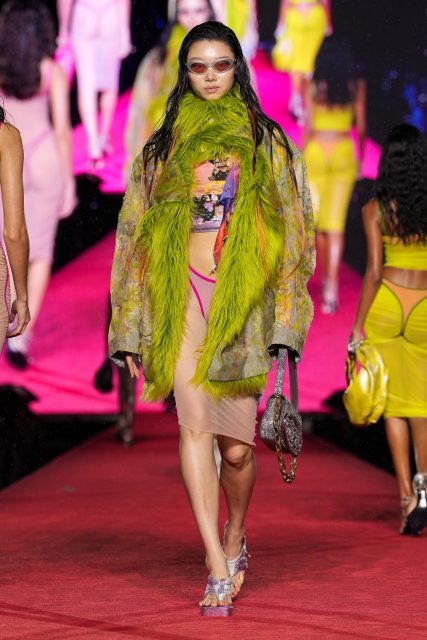Don’t let the slime, which dripped and slapped down the middle of the peachy-pink mesh steel runway at Prada today, fool you. It might make good quote-unquote content—it certainly did when it poured down at the men’s show in June—but this was a collection devoted to craft and technique. Surrounded by reporters backstage, Miuccia Prada said, “I got tired talking about ideas—let’s talk about clothes.”
Aren’t all runway shows about clothes? Well, yes, but as Raf Simons went on to explain, “craft isn’t something that gets talked about a lot at Prada, at least not as much as at other houses. We wanted to show what we could do.” It wasn’t a matter of how many hours it took to embroider this and how many petites mains were involved in making that. “That’s irrelevant,” he said with a wave of his hand. “The figuring out if it can be done” was the part that got him and Prada going. Two techniques, in particular, got special mention from Simons. The first was the printed fringe they used on floral shirts that gave the individual blooms a shifting depth. And the second was the long skeins of metal fringe used for skirts “built like jewelry.” They’re conversation starters, for sure.
Prada has very much been in the fashion conversation lately. Last year’s revenues jumped 21% over 2021, but you don’t have to know the company’s financials to understand that it’s resonating. Up and down the front rows, you see its pointy-toe kitten-heel slingbacks, and across the market they’ve spawned twisted-lady shoe lookalikes. With its emphasis on the crafts of the eccentric variety—both weathered and patched-together leather and panné velvet were affixed with firework swirls of crystal, and there was yet more fringe embellished with metal eyelets—this collection seemed destined to foil the copycats, though doubtless they’ll try.
Like the men’s spring show, the foundation here was a tailored silhouette: broad-shoulder shacket (with the cuffs of a shirt and the lapels of a jacket) tucked into the belted waistband of high-rise shorts or front-pleat, tapering-to-the-ankle pants. Some of these odd suits were swathed in sheer printed scarves that the show notes described as “fragments of dresses.” Their ethereality provided a link to the collection’s other key shape, sleeveless shifts with ’60s-via-the-’90s lines made from organza and gazar of such gossamer fineness they seemed to float down the runway.
A couple of other things that got people talking: the already-worn-in barn jackets (why not wear one over a Jazz Age flapper dress?) and the hand-carved mythological-man clasps adorning evening bags that reproduced a shape first designed in 1913 by Prada’s grandfather, who traveled the world picking up unique baubles like those carvings.
Fabio Zambernardi, the design director of Prada and Miu Miu and Miuccia’s closest collaborator who resigned this year after three decades at the company, joined the designers for a bow, doffing his cap, embracing them both, and inspiring a standing ovation in the process. Behind the glossy—or in this case, gooey—surface, many hands worked mightily on this knockout collection.
Read Next
“It’s About Togetherness”— Diesel’s Glenn Martens Shows At A Free Rave For 7,000
Editor
Nicole PhelpsCredit
Lead image: Isidore Montag / Gorunway.com

